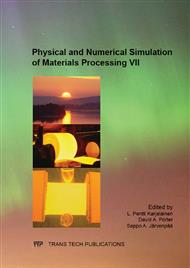p.224
p.230
p.236
p.242
p.248
p.253
p.261
p.266
p.277
Three Phase CFD-Simulation of CAS-OB Ladle
Abstract:
In the production of steel, the CAS-OB process is used for composition adjustment, temperature control and removal of various dissolved impurities. In this work we have studied the CAS-OB process with CFD and focused on the behavior of the slag layer, which is produced on the top of molten steel. Dynamic mesh adaption has been applied to resolve the slag layer boundary in a detailed way. As a result the time dependent evolution of the slag layer is presented. The chosen approach to describe the process offers an effective and promising way to study this complex system. In the future this model will be validated against experimental data.
Info:
Periodical:
Pages:
248-252
Citation:
Online since:
July 2013
Authors:
Price:
Сopyright:
© 2013 Trans Tech Publications Ltd. All Rights Reserved
Share:
Citation:


